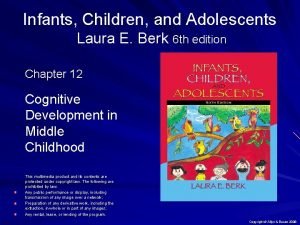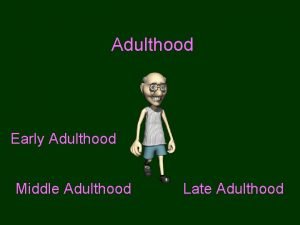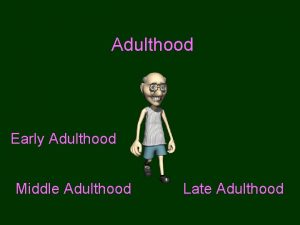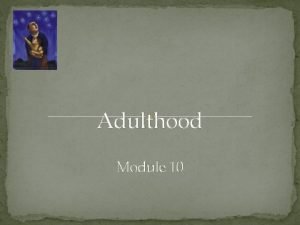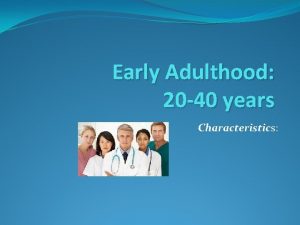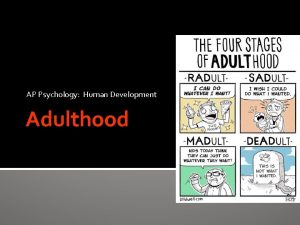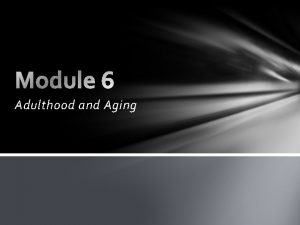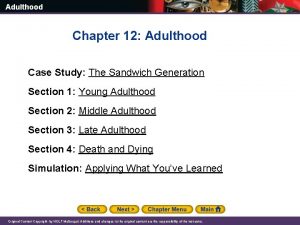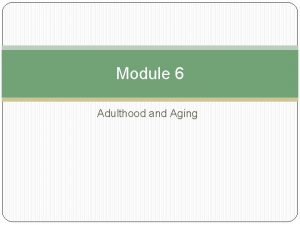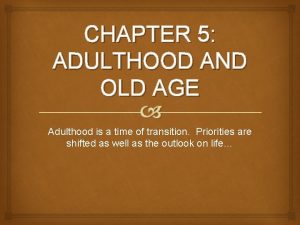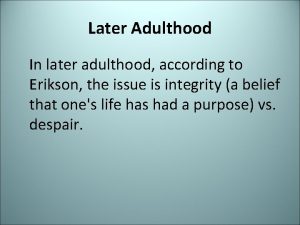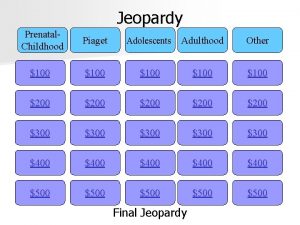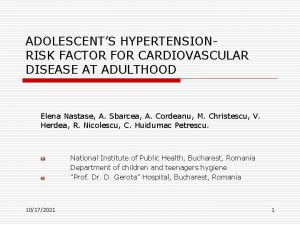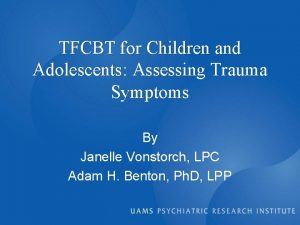managing transition to Adulthood for Adolescents living with


































- Slides: 34

managing transition to Adulthood for Adolescents living with HIV Experiences from e. Thekwini AWACC Elangeni Hotel, Durban 19 Nov 2015 1

Adolescence – the inevitable maze Alexandra Nechita 2

Our future… their future view. l l Client lists 3 life goals (High VL) versus her sister’s life goals (LDL) - l “To help my family “ l “ To be with my family “ l “To be good in my schoolwork “ Versus l “ Finish my studies( all of it)” l “ Doctor ( go to medical school )” l “ Actress ( act in horror movies )” 3

Growing up… society in transition External Internal 4

Outline l Part 1: Background – Why should I pay attention? l Part 2: Towards Adolescent and Youth friendly health services l Part 3: Clinical Cases – any quick fixes? l Part 4: Transition to Adulthood 5

HIV Prevalence by Age, Gender in South Africa (2012) Adolescent girls 15 -19 are up to 8 times, while young women 20 -24 are more than 3 times, more likely to be infected with HIV than their male peers.

Summary of epidemiology l l Adolescents (aged 10 -19) accounted for an estimated 25% of all HIV infections in South Africa Centre of the epidemic in terms of infection rates (incidence up to 2. 54 in young females), vulnerability (teenage pregnancy, risk behaviour, gender-based violence, inequalities and impact) Increasing numbers of perinatally infected children are now reaching adolescence Increasing access to HCT and ART 7

What about health system response? Not a child, not yet an… a I amal re T L U AD 8

Focus on the cascade… 90% of all people living with HIV will know their HIV status Test • HCT Outreach Support • Linkage to therapy 90% of all people diagnosed with HIV will receive sustained antiretroviral therapy. Treat • Early Paediatri c Rx Initiation • Focus • Geogra phic 90% of all people receiving antiretroviral therapy will have durable suppression. Optim ise • Adolesce nt Transitio n • Risk of treatment failure 9

The e. Thekwini HIV treatment cascade 5% 17 % 10

Part 1: Take home messages Background – Why should I pay attention? l l l This is a sizable population A growing population at the heart of the HIV epidemic It is a unique population - labile physiological growth phase – pivotal to future productivity and function Adolescents embody every community's hopes for the future. Adolescence is a time of vibrancy, self-discovery and rapid change or growth Not children and not yet adults Health care providers and health system ill equipped to deliver clinical and psychological services to adolescents living with HIV infection 11

Questions and Answers Q. The adolescent package of HIV care closely resembles the package of HIV care for adults; however, the way services are delivered can impact their success among adolescents. a) True b) False 12

Adolescent Youth Friendly Services l l l Advocacyl There are successful models of adolescent HIV MDT care and treatment Baseline services. These models Training can be adapted and Planning scaled-up nationally. Quality cycle l Health workers need the knowledge and skills to meet the specific needs of adolescent clients. 13

Characteristics of Youth-Friendly Services Program design characteristics: n n n n Youth involvement in program design and monitoring Drop-in clients welcomed Short waiting times Set up to provide chronic disease management Appointment and tracking systems in place Affordable or free services Publicity materials that inform and reassure n n n Friendly to male and female clients “ 1 -stop shopping” Referrals to clinical and community-based services Youth-friendly educational materials available to take away Youth support groups Peer Educators available Source: Senderowitz, J. , Solter, C. , & Hainsworth, G. (2004). Comprehensive reproductive health and family planning training curriculum. 16: Reproductive health services for adolescents. Watertown, MA: Pathfinder International. 14

AYFS - implementation 15

Effective adolescent interventions l l Motivational interviewing Cognitive Behavioural Incentives Technology *The Adolescent Medicine Network For HIV/AIDS prevention *The Lancet 2014 – Rashida Ferrand et al 16

Challenges l l l l l Health education, human rights Testing during adolescence Condom use and prevention Access to treatment and care Substance use Isolation / psychological transition and social complexity Have unique psychological, cognitive, physiological and neurological developmental issues Risk-taking behaviour Adherence, Amplified barriers Goals include wellness, economic participation and 17 social cohesion

Part 2: Take home messages Towards Adolescent and Youth friendly health services l Regardless of how long they have been infected or how they acquired HIV, the package of care for all ALHIV is very similar. l The approach for all adolescents should be familycentered and developmentally appropriate. l While the components of the adolescent package of HIV care closely resemble those of the adult package, the way these components are delivered has an important impact on their uptake and success among adolescents. 18

A case of disclosure l Date CD 4 VL log ARV regime 39. 22% Viral load Baseline 25. 05. 2012 1642 / 43. 7% LDL 14. 02. 2013 1948/40. 14% - D 4 t/3 TC/EF V ABC/3 TC/E FV 18. 02. 2013 - LDL 31. 03. 2014 991/ 34, 28% 6567 3, 82 15. 09. 2014 - 1133 3. 05 8. 05. 2015 1133 / 33. 97 14963 4. 18 11. 08. 2015 <40 <1. 6 l l 13 year old male Started ARVs at CHC: 01/05/2005: D 4 t/3 TC/EFV Transferred to Regional: Nov 2011 28/02/2012 ABC/3 TC/EFV – Lipodystrophy on Stavudine Partial disclosure: 5/12/2014 revisited disclosure counselling 19 4/2/15 + 6/8/15.

A case of recurrent defaulting Date CD 4 Viral load VL log Baseline 25. 09 18. 01. 10 623 / 14% 170000 7. 04. 09 LDL 785668 5. 90 822 / 23% l l 204 / 16. 19 % 24. 11. 2009 822 / 23% LDL D 4 t/3 TC/E FV ABC/3 TC/ EFV 11. 10. 2012 362/ 14. 45% 18. 12. 2013 361 / 13. 64% 03. 04. 2014 439 / 17. 64% 08. 12. 2014 - 245506 5. 39 - 189031 209209 5. 32 20. 03. 2015 - 84483 4. 93 8. 05. 2015 - 30. 08. 2011 2. 09. 2011 214 / 12. 49% 09. 06. 2015 - ART regime l l l 296146 5. 47 l 12 year old male ART started: 6. 07. 2009: D 4 T/3 TC/EFV PTB on abn CXR / TB symptoms/ smear negative: 10. 05. 2010 Defaulted ART for 4 months. Returned to care on 30. 05. 2011. Restarted TB meds for Disseminated TB Restarted ART at Regional: Aug 2011: ABC/3 TC/EFV Transfer ART care to CHC 20. 10. 2011. Defaulted again for 7 months: May – Dec 2014 Returned back to care: 5. 12. 201420 Reinitiated ART: 18. 12. 2014:

A case of peer support group intervention Date CD 4 VL log ARV regime 287 / 16. 4% 552 2, 74 316 / 22. 47% 252 / 18. 22% - 6027 3. 78 AZT/3 TC/LP Vr 3677 3. 57 282 2. 45 - < 150 17. 01. 20 301 13 5. 02. 201 4 19. 11. 20 14 6. 08. 201 4 10. 06. 20 15 7. 10. 201 5 Viral load 6332 ? l l l 18 year old male ART started: 11. 03. 2009: D 4 t/3 TC/EFV Current ART: second line: AZT/3 TC/LPVr ? Exact date of initiation: old file lost Full disclosure: 19. 03. 2014 21

Part 3: Take home messages Clinical cases l l l Managing adolescent cases is difficult One size does not fit all There are no quick fixes A multidisciplinary approach is required A plan is required Follow-up by the same team keeps things going forward 22

Questions and Answers (Continued) Q. Disclosure to a child or adolescent is a one-time event for which the caregiver must be wellprepared. a) True b) False 23

Disclosure Process 24 SA HIV Disclosure Guidelines for Children and Adoles

Disclosure: Key Points l l Disclosure is an ongoing process, not a one-time event. Disclosure can help young clients access prevention, care, treatment, and support. It can also improve adherence, reduce stigma and discrimination, and slow the spread of HIV by helping people protect themselves and their partners. Disclosure can result in health benefits for the child/ adolescent and caregiver. Health workers and caregivers may face barriers to disclosure, such as not knowing where to start or feeling concerned about harming the child/adolescent. 25

Questions and Answers Q. Adherence preparation and ART initiation can usually be completed in 1 visit. a) True b) False 26

Risk to treatment failure (ROTF): Purpose Ø Ø Ø Provide structured adherence support for patients with HIGH viral loads Provide standardised adherence messages to common adherence barriers Prolong the duration of Viral Load suppression on 1 st line and 2 nd line ART Ensure timely and successful regimen changes Limit the need for 3 rd line ART

Role of MDT in ROTF Enhanced Counselling l l Administrative staff – Get and review results, can flag the patient’s file, enter results/data on Tier. net Counsellor – Offer standardised adherence messages and motivate patient. Facilitate support groups Nurse/ Doctor – Standardised adherence support, clinical support, viral load monitoring and correct regimen choice. Social Worker- Address psychosocial Issues

Summary of steps on the ROTF adherence worksheet Session 1 – intensive Session 2 Session 3 Viral load education review Discuss adherence difficulties from month before / come up with solutions Patient’s reason for high viral load Mistakes in adherence Follow up on referrals made Time meds are taken + create Follow up on referrals made TX plan Do VL bloods for VL > 1000 group * Storing meds + emergency supply (VL for 400 -1000 group will be done at visit 5) Preparing for travel/ trips away from home Motivation card Support system Planning for drug/alcohol use Session 4: • Discuss VL results* • Discuss adherence problems • Plan a way forward Getting to clinic appointments Adapted from MSF Khayelitsha Treatment Failure Model

Adolescent support groups l l l l l Teens only communicate with other teens Peer Pressure Peer Counsellors All have similar anxieties fears questions Eg Sexuality, prognosis, child bearing, disclosure , preventing transmission, transitioning to adults Logical to discuss these in a group Run by responsible person that teens trust Can be run by older teens themselves with adult supervision Set programme of topics for discussion 30

Health Education and Related Topics That Can Be Incorporated into Support Group Meetings: l Positive living l Finding work l Adherence l l Disclosure Strategies to reduce gender- based violence l Sexual and reproductive health l Dealing with stigma l Nutrition l Relationships and sexuality l l Preventing new HIV infections and positive prevention Getting help for mental health problems l Dealing with dying and the death of a friend or family member l Managing disabilities l Preventing OIs l Coping with school 31

Transition from Pediatric to Adult Care l l l The goal of transition is to ensure the provision of uninterrupted, coordinated, developmentally- and ageappropriate, and comprehensive care before, during, and after the transition. ALHIV may face challenges: l In their transition to adult care l In learning to independently manage their own care These challenges affect ALHIV, their caregivers, and health workers in pediatric and adult clinics. 32

Key Considerations for the Transition to Adult Care l All adolescents require support both within and outside of the clinic setting to take greater ownership over their health care, behavior, lives, and adherence. l The transition to adult care often occurs in parallel with an adolescent’s emotional and physical maturation. Effective transition must allow for the fact that adolescents are undergoing changes that impact much more than just their clinical care. l Health workers should: l l l Help ALHIV set and achieve goals for independence and self -management of care Encourage ALHIV to develop as much independence as 33 possible Support caregivers to understand their changing role

Part 4: Take home messages Transition towards adulthood l l l l Communication – seek first to understand Managing the process, communication within the health system Facility ownership of transition service – know and monitor your own data and targets Managing Disclosure Risk of treatment failure Adolescent Support Groups Creating a future worth striving for 34
 Adolescents defenition
Adolescents defenition Berk 8th edition
Berk 8th edition Infants, children, and adolescents 8th edition
Infants, children, and adolescents 8th edition What is the smallest living unit
What is the smallest living unit Whats an energy pyramid
Whats an energy pyramid Is tomato living or nonliving
Is tomato living or nonliving Living non living dead
Living non living dead Stål för stötfångarsystem
Stål för stötfångarsystem Orubbliga rättigheter
Orubbliga rättigheter Big brother rösta
Big brother rösta Adressändring ideell förening
Adressändring ideell förening Verktyg för automatisering av utbetalningar
Verktyg för automatisering av utbetalningar Texter för hinduer tantra
Texter för hinduer tantra Expektans
Expektans I gullregnens månad
I gullregnens månad Stig kerman
Stig kerman Strategi för svensk viltförvaltning
Strategi för svensk viltförvaltning Vad är verksamhetsanalys
Vad är verksamhetsanalys Tack för att ni har lyssnat
Tack för att ni har lyssnat Läkarutlåtande för livränta
Läkarutlåtande för livränta Klassificeringsstruktur för kommunala verksamheter
Klassificeringsstruktur för kommunala verksamheter Returpilarna
Returpilarna Centrum för kunskap och säkerhet
Centrum för kunskap och säkerhet Inköpsprocessen steg för steg
Inköpsprocessen steg för steg Påbyggnader för flakfordon
Påbyggnader för flakfordon Anatomi organ reproduksi
Anatomi organ reproduksi Egg för emanuel
Egg för emanuel Atmosfr
Atmosfr Formula varians
Formula varians Tidbok för yrkesförare
Tidbok för yrkesförare Rutin för avvikelsehantering
Rutin för avvikelsehantering Vad är vanlig celldelning
Vad är vanlig celldelning Presentera för publik crossboss
Presentera för publik crossboss Kontinuitetshantering i praktiken
Kontinuitetshantering i praktiken Myndigheten för delaktighet
Myndigheten för delaktighet


